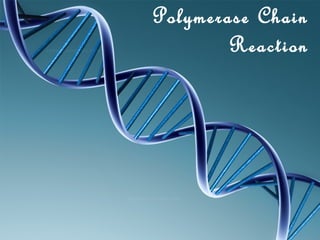
Polymerase chain reaction
- 1. Polymerase Chain Reaction
- 2. Contents • What is PCR? • History of PCR • Components of PCR • Principles of PCR • Basic Requirements • Instrumentation • PCR Programme • Advantages of PCR • Applications of PCR
- 3. What is PCR? • PCR is a technique that takes specific sequence of DNA of small amount and amplifies it to be used for further testing. • In vitro technique
- 4. Short History of PCR • 1983: Dr. Kary Mullis developed PCR • 1985: First publication of PCR by Cetus Corporation appears in Science. • 1986: Purified Taq polymerase is first used in PCR • 1988: PerkinElmer introduces the automated thermal cycler. • 1989: Science declares Taq polymerase "molecule of the year.
- 5. Short History of PCR • 1990: amplification and detection of specific DNA sequences using a fluorescent DNA-binding dye, laying the foundation for future "real-time" or "kinetic" PCR. • 1991: RT-PCR is developed using a single thermostable polymerase, rTth, facilitating diagnostic tests for RNA viruses. • 1993:Dr. Kary Mullis shares Nobel Prize in Chemistry for conceiving PCR technology.
- 6. Short History of PCR • 1999: Dynal launches DRB-36 HLA-typing kit for tissue typing. • 2003: HIV-1 MONITOR Test, version 1.5 Product Family • AMPLICOR® CT/NG Test for Chlamydia trachomatis, • AMPLICOR® CT/NG Test for Neisseria gonorrhoeae
- 8. Purpose • To amplify a lot of double-stranded DNA molecules (fragments) with same (identical) size and sequence by enzymatic method and cycling condition.
- 9. Condition • 1. Denaturation of ds DNA template • 2. Annealing of primers • 3. Extension of ds DNA molecules
- 10. Denaturation • Temperature: 92-94C • Double stranded DNA melts single stranded DNA 5’ 3’ 3’ 5’ 92C 5’ 3’ + 3’ 5’
- 11. Annealing • Temperature: ~50-70C (dependant on the melting temperature of the expected duplex) • Primers bind to their complementary sequences 5’ 3’ Forward primer Reverse primer 3’ 5’
- 12. Extension • Temperature: ~72C • Time: 0.5-3min • DNA polymerase binds to the annealed primers and extends DNA at the 3’ end of the chain Taq 5’ Taq 3’ 5’
- 13. Cycling
- 14. Products of Extension 5’ 3’ Taq 3’ 5’ 5’ 3’ 3’ 5’ Taq
- 15. Overall Principle of PCR • DNA – 1 copy • Known sequence Sequence of interest Known sequence • PCR
- 16. Chemical Components • Magnesium chloride: .5-2.5mM • Buffer: pH 8.3-8.8 • dNTPs: 20-200µM • Primers: 0.1-0.5µM • DNA Polymerase: 1-2.5 units • Target DNA: ≤ 1 µg
- 17. Basic requirements for PCR reaction • 1) DNA sequence of target region must be known. 2) Primers - typically 20-30 bases in size. These can be readily produced by commercial companies. Can also be prepared using a DNA synthesizer
- 18. Basic requirements for PCR reaction • 3) Thermo-stable DNA polymerase - eg Taq polymerase which is not inactivated by heating to 95C 4) DNA thermal cycler - machine which can be programmed to carry out heating and cooling of samples over a number of cycles.
- 19. Instrumentation
- 25. Three Aspects of PCR • Specificity • Efficiency • Fidelity
- 26. Things to try if PCR does not work • A)If no product ( of correct size ) produced: –1 Check DNA quality –2 Reduce annealing temperature –3 Increase magnesium concentration –4 Add dimethylsulphoxide ( DMSO ) to assay ( at around 10% ) – 5 Use different thermostable enzyme – 6 Throw out primers - make new stocks
- 27. Things to try if PCR does not work • B) If extra spurious product bands present – 1 Increase annealing temperature – 2 Reduce magnesium concentration – 3 Reduce number of cycles – 4 Try different enzyme
- 28. Example of PCR programme • Initial denaturation 95C for 5 mins • Thermo-cycle file - 30 cycles of • Denaturation : 95C for 30 secs • Annealing : 55C for 30 secs • Extension : 72C for 45 secs • Final extension 72C for 5 mins • Holding ( soak ) file usually 4C
- 29. Advantages of PCR • Small amount of DNA is required per test • Result obtained more quickly - usually within 1 day for PCR • Usually not necessary to use radioactive material (32P) for PCR. • PCR is much more precise in determining the sizes of alleles - essential for some disorders. • PCR can be used to detect point mutations.
- 30. Applications of PCR • Neisseria gonorrhea • Chlamydia trachomatis • HIV-1 • Factor V Leiden • Forensic testing and many others
- 31. Applications of PCR Molecular Identification Sequencing Genetic Engineering Molecular Archaeology Bioinformatics Site-directed mutagenesis Molecular Epidemiology Genomic Cloning Gene Expression Studies Molecular Ecology Human Genome Project DNA fingerprinting Classification of organisms Genotyping Pre-natal diagnosis Mutation screening Drug discovery Genetic matching Detection of pathogens
- 32. Conclusion PCR is not only vital in the clinical laboratory by amplifying small amounts of DNA for STD detection, but it is also important for genetic predisposing for defects such as Factor V Leiden. The PCR technology can also be employed in law enforcement, genetic testing of animal stocks and vegetable hybrids, and drug screening along with many more areas.
